Intern Takeover – Planting trials in North Wales (February 2022)
On Friday the 28th of January, a team of us started preparing for a week of fieldwork up in North Wales. A group of humans and one fluffy, four-legged companion (definitely the favourite member of Project Seagrass) helped fill 800 hessian bags and 200 coconut pots with sand and seagrass seeds. These were to be used in the experiments which lay ahead!
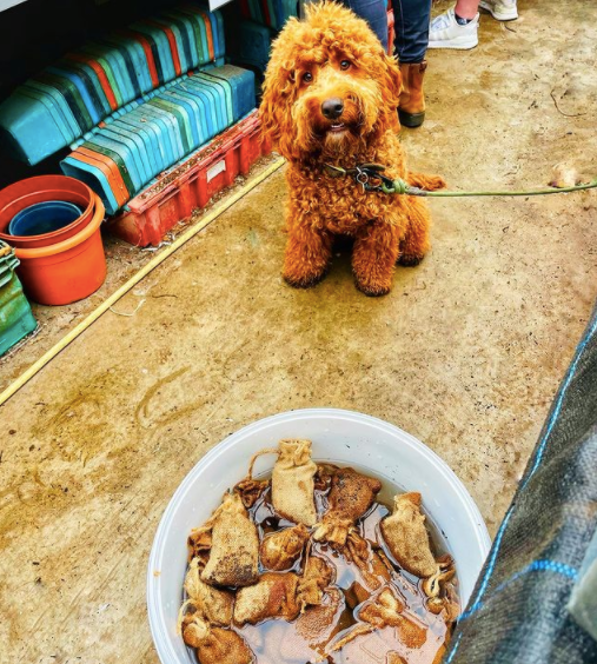
Bertie looking very proud of himself after assisting the team with their very busy morning ensuring all of the seeds were prepped and ready for North Wales.
The aim of this week was to help Lucy Coals with her PhD research project (a collaborative PhD with Deakin University, Swansea University and Project Seagrass), which is assessing how different site conditions and planting methods affect the success of seagrass germination and growth – how interesting, right?! This work is essential to help us better understand the conditions that seagrass prefers to grow in, including light and sedimentation preferences. Seagrass is very particular about its needs and is a very sensitive plant, so understanding the optimum conditions in which seagrass grows is SO important when considering things like site suitability for large-scale restoration efforts.
After a very scenic 4-hour drive, filled with the most beautiful welsh landscapes and two of our incredible national parks – Brecon Beacons and Snowdonia, 9 of our team arrived at the Llŷn Peninsula in sunny but cold (nothing new there…) North Wales. Once we arrived and settled in, we tucked into some yummy pasta and headed to bed, making sure we were well rested to start our busy week of field work!
Day 1:
After a morning full of briefing, organising equipment and kit, we made the hour-long trip to Traeth Bychan in Anglesey to reach the mid-afternoon low tide. An accidental wrong turn led us to the longest named train station in the world “Llanfairpwllgwyngyllgogerychwyrndrobwllllantysiliogogogoch” – a mistake that we were NOT complaining about. Finally, we arrived and kitted up in waders and warm clothes, then headed down to the beach. Lucy demonstrated her 3 different planting methods – planting using hessian bags, coconut pots (which were slightly more exposed) and DIS (dispenser injection seeding) which mixes seeds with mud and is injected directly into the sediment. We then got started with the planting experiments and took sediment samples to assess the organic content and pollution of this site.
After a busy first day we headed back to our accommodation, tired but in high spirits. There’s nothing quite like the feeling of completing the first day of fieldwork successfully after lots of stressful planning to ensure everything runs perfectly!
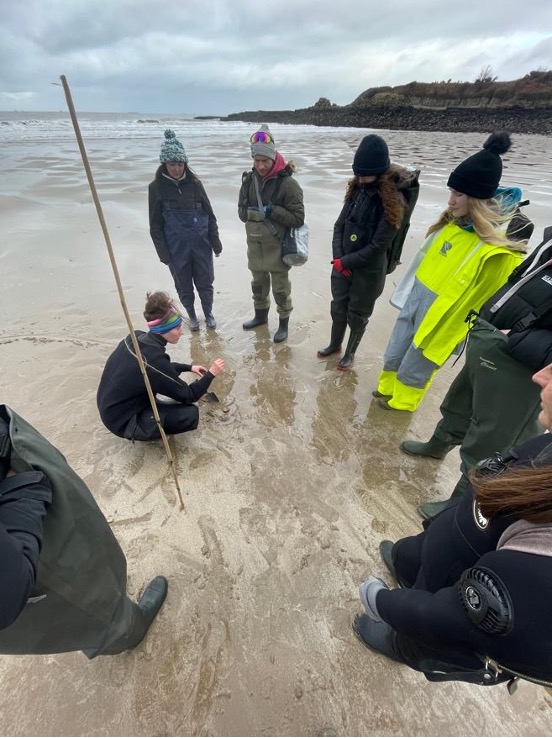
Lucy demonstrating how she wanted her experiments, in what order the different planting methods were to be used and the specific way they were to be planted… as the rest of us listened veryyyyy well (check out all of the concentrating faces!)
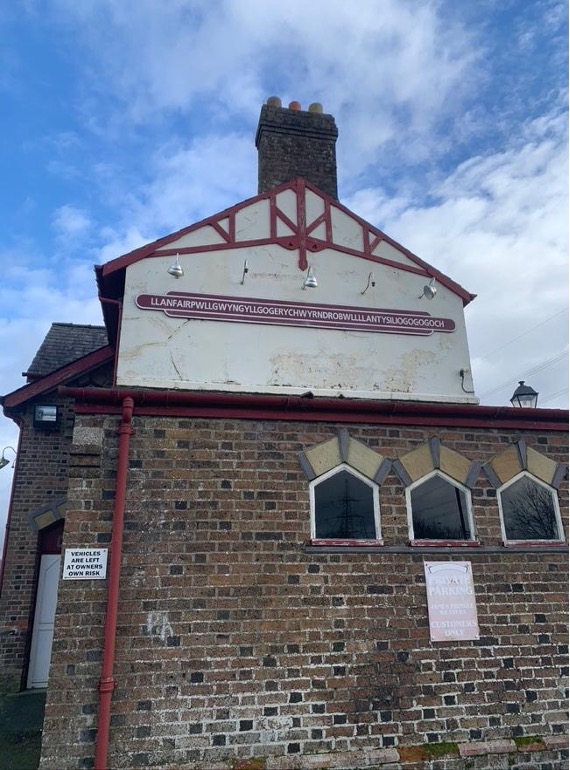
The longest train station in the world “Llanfairpwllgwyngyllgogerychwyrndrobwllllantysiliogogogoch” … go on… try and pronounce it, you know you want to!
Day 2:
We woke up feeling energised on Tuesday, with half the team deciding to head down to the local beach (Abersoch beach) for a cold-water morning dip. It was freezing and fantastic at the same time but what truly made it was the welcome that we received from the Abersoch dunkers group, who were not only the friendliest people on Earth but were also really interested in the work we were doing locally!
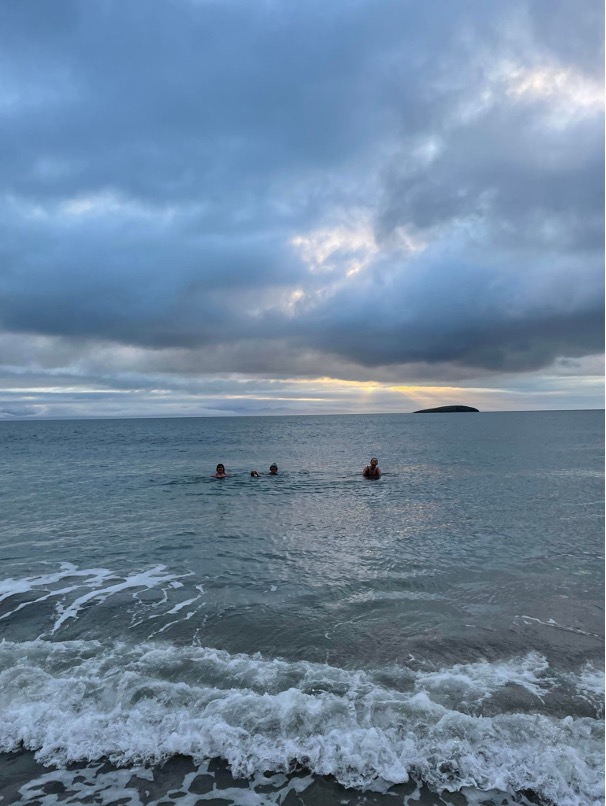
Our completely crazy, bonkers team having a wonderful cold morning dip at Abersoch beach – surprisingly, we all felt AMAZING after this dip… maybe there’s a reason why cold water swims are hyped up so much…
After another busy morning full of team briefings and preparing equipment and planting materials, we headed back up to gorgeous Anglesey. We split into two teams with half of us heading to Porth y Môr and the other half to Traeth Lligwy. Just like the day before we kitted up, walked to our site, set up the planting trials and took sediment samples when low tide hit – and that’s it! Another experiment set up and in full swing! Two sites down, another 2 to go!
Due to the nature of the afternoon low tide, we experienced an amazing purpley pink sunset across the beach, lifting team spirit and moral – as the week went on, we were fortunate enough to keep being awarded with these mesmerising, colourful sunsets.
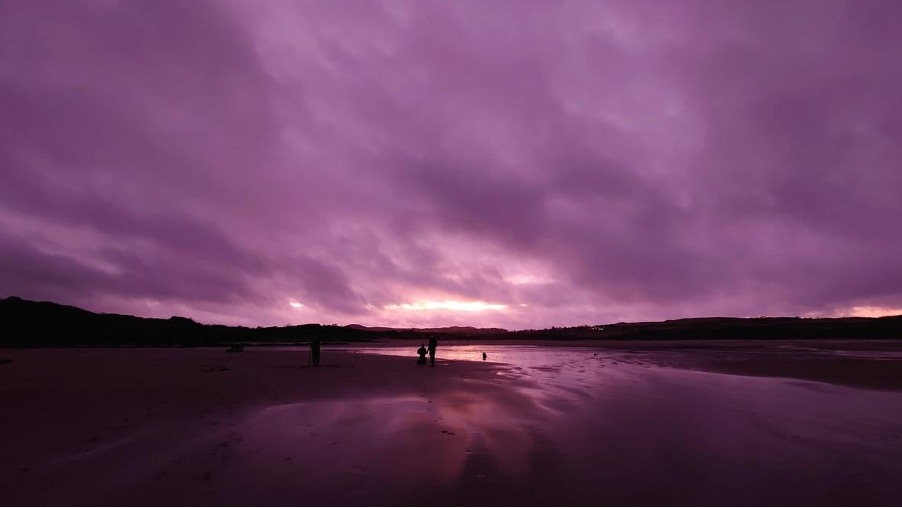
The most beautiful sunset over Traeth Lligwy filled with purple and pink hues. It’s times like these that you take a few moments to appreciate the beauty of our stunning planet. GOOSEBUMPS!
Day 3:
We started the day with a quick GPS refresher from Lucy, after a quickfire of ‘what does this button do?’ we were put into teams to search for nearby GPS points – a lot of fun and a little bit trickier than it may sound… needless to say we all learnt a lot and are definitely a little more confident when using a GPS.
Today we were heading to Penychain, where we spotted our first seagrass of the week – as you can imagine, the team of SEAGRASS ENTHUSIASTS were ecstatic with this discovery!
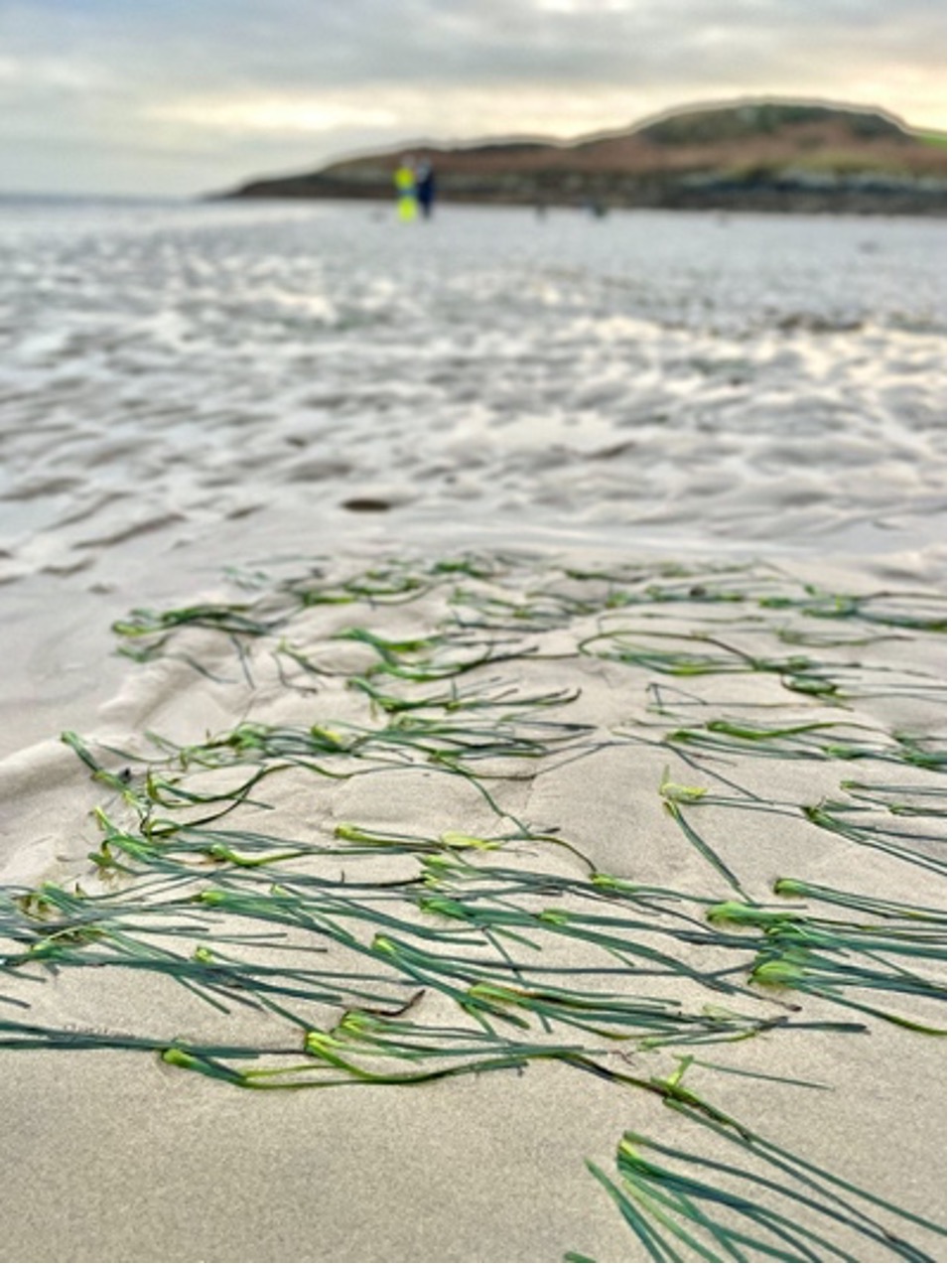
A beautiful patch of Zostera marina on Penychain beach… I mean… does anything compare to the vivid green leaves of a seagrass plant?? I think not.
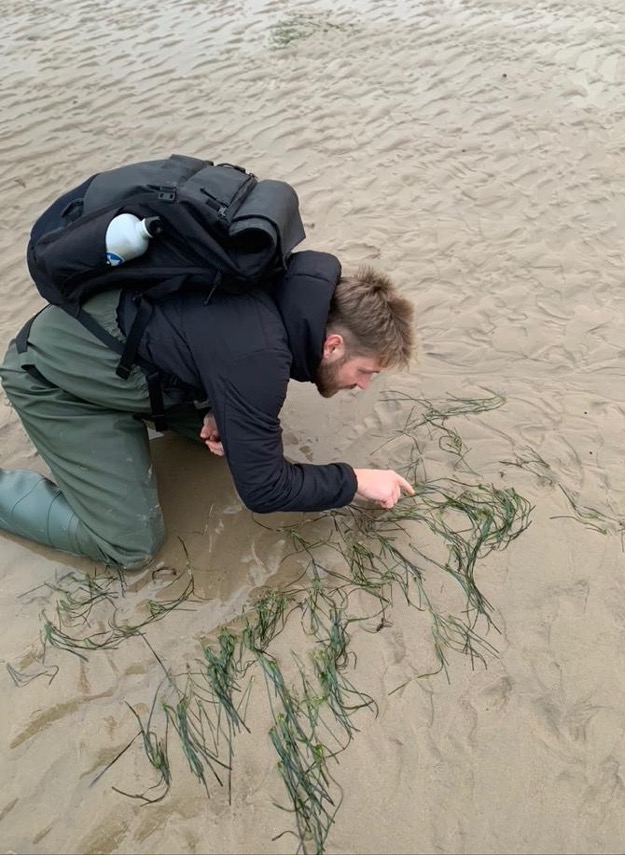
Ben in his element. We also added these sightings to Seagrass Spotter – remember to add yours too if you come across a patch of seagrass!!
When low tide hit, we got started on the experiments as normal but also did a site assessment – looking at the features of the beach like how much oxygen is in the sediment, what type of sediment was at the site (e.g muddy, sandy, gravelly), any signs of pollution (e.g runoff) and more general assessments like what organisms were present to be able to get a feel of whether this site may be suitable for seagrass growth.
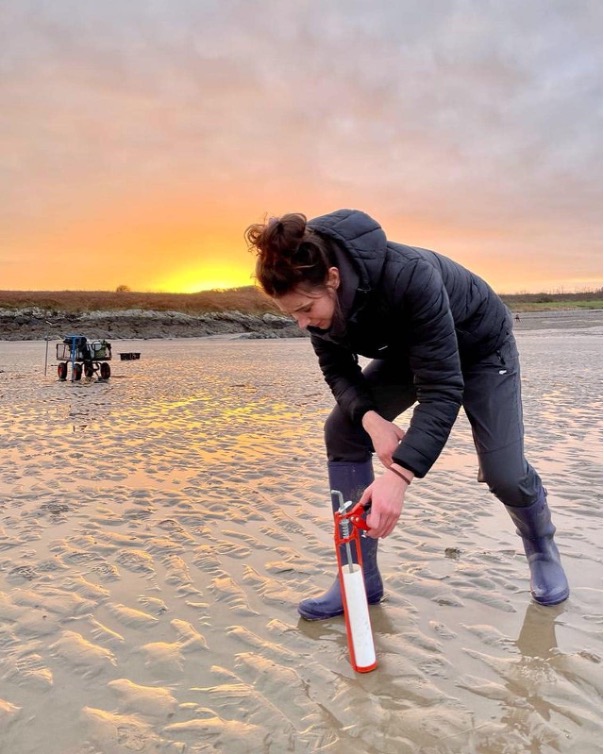
Lucy Coals using a DIS (dispenser injection seeding) to inject seeds into the sediment
Day 4:
Once again the team split up and headed to different locations. I (Lowri) teamed up with Anouska and Sam to collect some sediment cores from Porthdinllaen – which is home to my favourite seagrass meadow! After a quick species hunt like the children we are at heart (as marine biologists, it is simply impossible to not get excited over cool little invertebrates that you find in the field), we set off to do our actual work for the day – sediment cores!
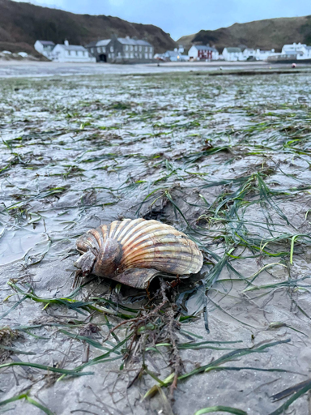
A scallop resting in the beautiful seagrass meadow of Porthdinllaen (too cool!!!)
Anouska Mendzil is specifically looking at heavy metal pollution. This is really interesting because it can give us an indication of human-induced pollution over time, whilst also having toxic effects to marine organisms leading to a decline or collapse in ecosystem health. Sediments act as sink for pollutants but they also can constitute a baseline which future anthropogenic effects can be assessed. Sediment is totally underappreciated and we can learn so much from it – especially about the history of our Earth, now isn’t that just fascinating?!
After a muddy, rainy and windy few hours, our samples were collected and the three of us had only one thing on our minds – FOOD! All of the team met up in a nearby restaurant to debrief and fuel up (much needed after a busy day).
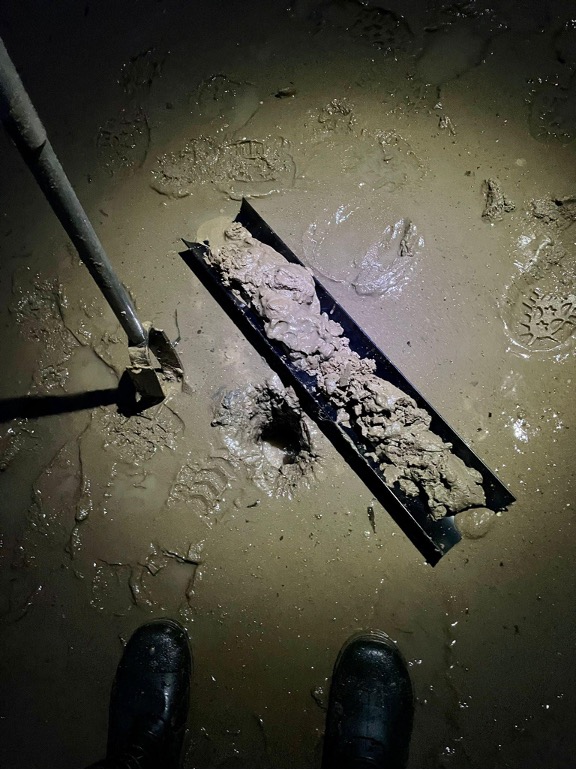
A sediment core taken at Porthdinllaen beach. Some samples were taken past daylight hours, hence the bright headtorch!
Day 5:
And just like that, it was already our final day of fieldwork! To start the day on a high, the whole team headed down to the beach for a cold water dip – not only did this wake us up (seriously, cold water works better than caffeine!) but it also ensured the day started on a massive high, full of positivity and drive.
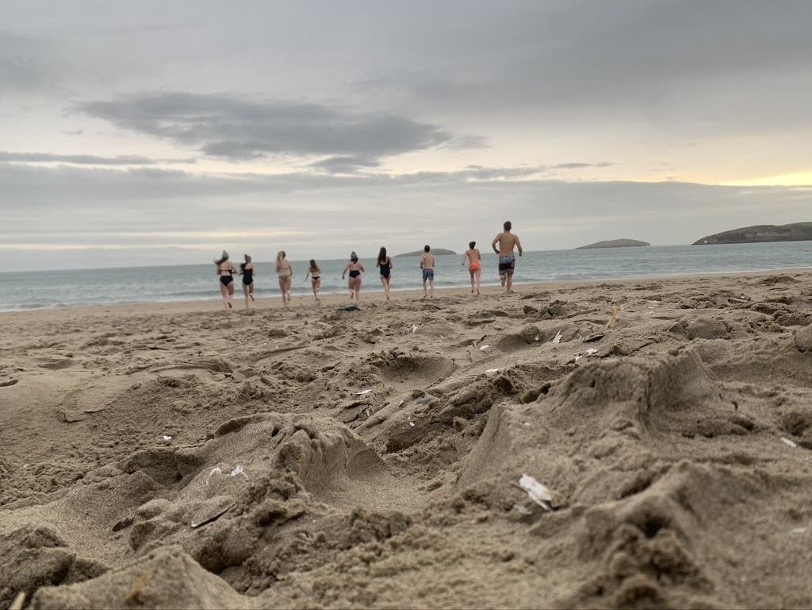
Team dip! This photo does not do the coldness justice. It was freezing… I promise.
Abersoch was to be our last site for planting trials, a lovely beach surrounded by the breath-taking views of Snowdonia National Park – what a treat to end our week! Possibly even more of a treat was the fact that the entire team were together once again after splitting up into teams to finish our intensive week together. We set up the last of our trials whilst another mesmerising sunset bloomed around us like a scene from a movie. The sense of togetherness and teamwork combined with the setting sun and beauty of Abersoch was one of the most memorable memories and highlights from the week.
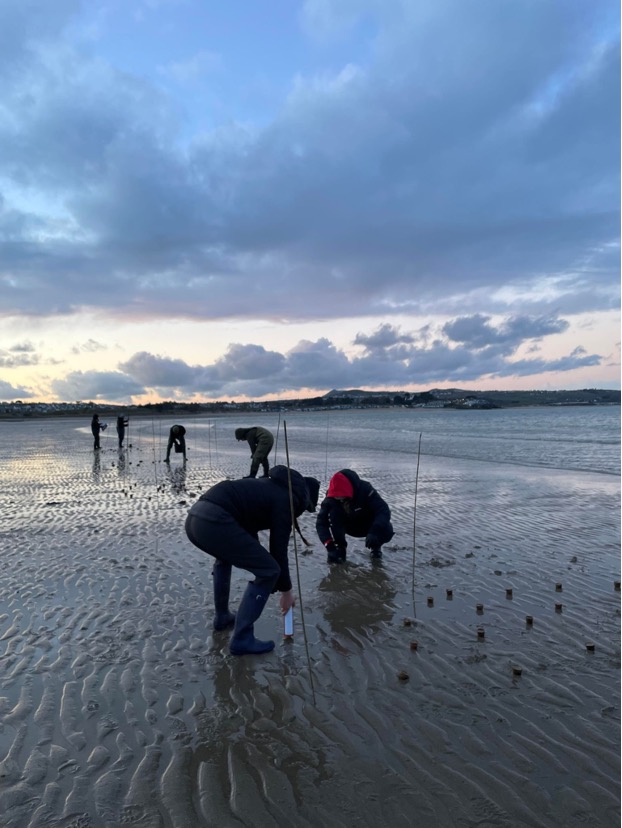
The busy team mid-setting up the experiments
After an exhausting (but fantastic) few days of planting, we celebrated a successful week at Crust Pizzeria in Abersoch, where we toasted the start of Lucy’s PhD experiments and the fantastic efforts of our team. As interns, it is great to have such a strong feeling of belonging, once team seagrass, you are always team seagrass – we really are a little seagrass family! Never have we ever felt so inspired and passionate about marine conservation and an urge to continue protecting our wonderful seagrass meadows. 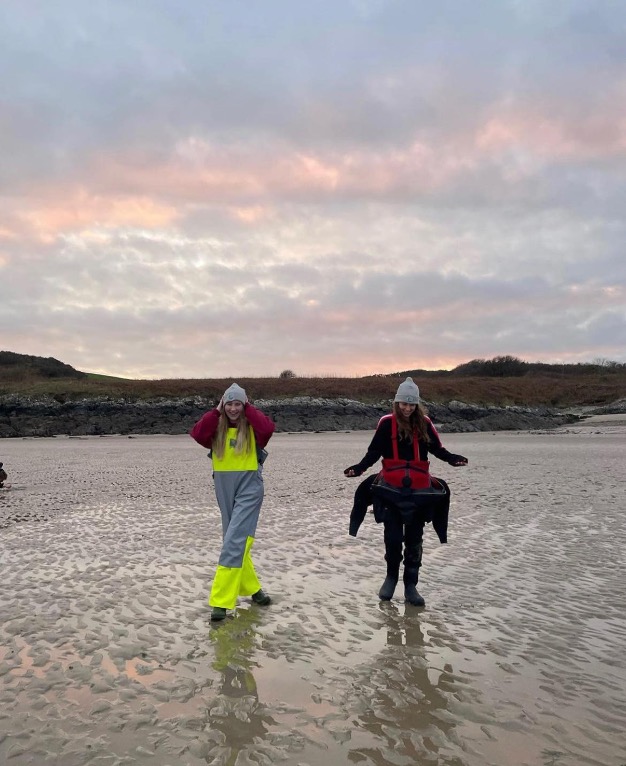
We hope you enjoyed reading about our fantastic week as much as we enjoyed reminiscing and writing this blog! – Lowri & Ellie
Cyfieithiad Cymraeg
Tro’r interniaid i gymryd drosto – Treialon plannu yng Ngogledd Cymru (Chwefror 2022)
Ar Ddydd Gwener yr 28ain o Ionawr, dechreuodd tîm ohonom baratoi ar gyfer wythnos o waith maes i fyny yng Ngogledd Cymru. Helpodd grŵp o fodau dynol ac un cydymaith pedair coes flewog (yn bendant hoff aelod Project Seagrass) i lenwi 800 o fagiau hesian a 200 o botiau cnau coco â hadau morwellt a thywod. Roedd y rhain i’w defnyddio yn yr arbrofion oedd o’n blaenau!

Bertie yn edrych yn falch iawn ohono’i hun ar ôl cynorthwyo’r tîm gyda’u bore prysur iawn yn sicrhau bod yr holl hadau wedi’u paratoi ac yn barod ar gyfer Gogledd Cymru.
Nod yr wythnos hon oedd helpu Lucy Coals gyda’i phroject ymchwil PhD (PhD cydweithredol â Phrifysgol Deakin, Prifysgol Abertawe a Project Seagrass), sy’n asesu sut mae amodau safle a dulliau plannu gwahanol yn effeithio ar lwyddiant egino a thyfiant morwellt – am brosiect hynod o ddiddorol?! Mae’r gwaith hwn yn hanfodol i’n helpu deall yr amodau y mae’n well gan forwellt dyfu ynddynt, gan gynnwys hoffterau golau a gwaddodiad. Mae morwellt yn benodol iawn am ei anghenion ac mae’n blanhigyn sensitif iawn, felly mae deall yr amodau gorau posibl y mae morwellt yn tyfu ynddynt YN HYNOD bwysig wrth ystyried pethau fel addasrwydd safle ar gyfer ymdrechion adfer morwellt ar raddfa fawr.
Ar ôl taith 4 awr olygfaol iawn, yn llawn o dirweddau harddaf Gymru gan gynnwys dau o’n parciau cenedlaethol anhygoel – Bannau Brycheiniog ac Eryri, cyrhaeddodd 9 o’n tîm i Ben Llŷn heulog ond hynod o oer (dim byd newydd am Gymru yno…). Unwaith i ni gyrraedd a setlo i mewn, fe wnaethon ni bwyta pasta blasus a mynd i’r gwely, gan wneud yn siŵr ein bod wedi gorffwys yn dda i ddechrau ein hwythnos brysur o waith maes!
Diwrnod 1:
Ar ôl bore llawn briffio a threfnu offer a chit, fe wnaethom y daith awr o hyd i Draeth Bychan yn Ynys Môn i gyrraedd y llanw isel ganol prynhawn. Arweiniodd tro anghywir at yr orsaf drên a’r enw hiraf yn y byd “Llanfairpwllgwyngyllgogerychwyrndrobwllllantysiliogogogoch” – camgymeriad NAD oeddem yn cwyno amdano. O’r diwedd, cyraeddasom a newidiasom ni mewn i ein citiau a rhagor o ddillad cynnes, yna aethom i lawr i’r traeth. Dangosodd Lucy ei 3 dull plannu gwahanol – plannu gan ddefnyddio bagiau hesian, potiau cnau coco (a oedd ychydig yn fwy agored i’r elfennau) a DIS (dosbarthwr chwistrelliad hadau) sy’n cymysgu hadau â mwd ac yn cael ei chwistrellu’n uniongyrchol i’r gwaddod. Yna fe ddechreuon ni gyda’r arbrofion plannu a chymerasom samplau gwaddod i asesu cynnwys organig a llygredd y safle hwn.
Ar ôl diwrnod cyntaf prysur, aethom yn ôl i’n llety, yn flinedig ond mewn hwyliau da. Does dim byd tebyg i’r teimlad o gwblhau’r diwrnod cyntaf o waith maes yn llwyddiannus ar ôl llawer o gynllunio dirdynnol i sicrhau bod popeth yn rhedeg yn ysgafn!

Lucy yn arddangos sut roedd hi eisiau ei harbrofion, ym mha drefn roedd y gwahanol ddulliau plannu i’w defnyddio a’r ffordd benodol i’w plannu… wrth i’r gweddill ohonom wrando’n ofalus iawn (edrychwch ar bob un o’r wynebau yn canolbwyntio!)

Yr orsaf drên a’r enw hiraf yn y byd “Llanfairpwllgwyngyllgogerychwyrndrobwllllantysiliogogogoch. Yn y cyfieithiad Saesneg, rydym yn ofyn i chi drio ynganu’r enw’r orsaf ond os ydych yn gallu siarad Cymraeg mae’n debyg mai dyma’ch tric parti eisoes…
Diwrnod 2:
Deffrom yn teimlo’n llawn egni, gyda hanner y tîm yn penderfynu mynd lawr i’r traeth lleol (traeth Abersoch) am dip dŵr oer. Roedd yn rhewllyd ac yn rhyfeddol ar yr un pryd ond yr hyn a’i gwnaeth yn hyd yn oed yn well oedd y croeso a gawsom gan y grŵp ‘Abersoch dunkers’, a oedd nid yn unig y bobl fwyaf cyfeillgar ar y Ddaear ond hefyd â diddordeb mawr yn y gwaith yr oeddem yn ei wneud yn lleol!

Ein tîm hollol wallgof, boncyrs yn cael dip oer bendigedig ar draeth Abersoch – roedden ni i gyd yn teimlo’n ANHYGOEL ar ôl y bore hwn… efallai fod rheswm pam fod nofio dŵr oer yn cael ei brolio cymaint… dyma beth annisgwyl!
Ar ôl bore hectig arall llawn sesiynau briffio tîm a pharatoi offer a deunyddiau plannu, aethom yn ôl i Ynys Môn. Rhannwyd yn ddau dîm gyda hanner ohonom yn mynd i Borth y Môr a’r hanner arall i Draeth Lligwy. Yn union fel y diwrnod cyn, cerddasom ni i’n safle, sefydlon y treialon plannu a chymeron samplau gwaddod pan darodd y llanw isel – a dyna ni! Arbrawf arall wedi ei sefydlu ac ar ei anterth! Dau safle i lawr, 2 arall i fynd!
Oherwydd natur llanw isel y prynhawn, cafwyd machlud haul pinc porffor anhygoel ar draws y traeth, gan godi ysbryd tîm a moesoldeb – wrth i’r wythnos fynd yn ei blaen, roeddem yn ddigon ffodus i barhau i gael ein gwobrwyo â’r machlud hudolus, lliwgar hyn.

Roedd y machlud harddaf dros Draeth Lligwy yn llawn arlliwiau porffor a phinc. Ar adegau fel hyn rydych chi’n cymryd ychydig o eiliadau i werthfawrogi harddwch ein planed anhygoel. Goosebumps!
Diwrnod 3:
Dechreuon ni’r diwrnod gyda sesiwn gloywi GPS cyflym gyda Lucy, ar ôl taniad cyflym o ‘beth mae’r botwm hwn yn ei wneud?’ cawsom ein rhoi mewn timau i chwilio am bwyntiau GPS cyfagos – llawer o hwyl ac ychydig yn fwy anoddach nag y mae’n swnio… Afraid dweud ein bod ni i gyd wedi dysgu llawer ac yn bendant ychydig yn fwy hyderus wrth ddefnyddio GPS.
Heddiw roeddem ar ein ffordd i Benychain, lle gwelsom ein morwellt cyntaf yr wythnos – fel y gallwch ddychmygu, roedd y tîm o SELOGION MORWELLT wrth eu bodd gyda’r darganfyddiad hwn!

Clytiau hardd o wellt y gamlas (Zostera marina) ar draeth Penychain… a oes unrhyw beth yn cymharu â dail gwyrdd llachar planhigyn morwellt?? Dydw i ddim yn argyhoeddedig…

Ben yn ei elfen. Fe wnaethom hefyd ychwanegu lluniau o’r hyn a welsom ar SeagrassSpotter- cofiwch ychwanegu eich rhai chi hefyd os dewch ar draws clwt o forwellt!!
Pan darodd y llanw isel, fe ddechreuon ni ar yr arbrofion fel arfer ond hefyd heddiw gwnaethon ni asesiad safle – edrych ar nodweddion y traeth fel faint o ocsigen sydd yn y gwaddod, pa fath o waddod oedd yn y safle (e.e mwdlyd, tywodlyd, graeanog), unrhyw arwyddion o lygredd (e.e dŵr ffo, olew ar y traeth) ac asesiadau mwy cyffredinol fel pa organebau oedd yn bresennol, er mwyn gallu cael syniad a allai’r safle hwn fod yn addas ar gyfer tyfiant morwellt.

Lucy Coals yn defnyddio DIS (dosbarthwr chwistrelliad hadau) i chwistrellu hadau i mewn i’r gwaddod.
Diwrnod 4:
Unwaith eto gwahanodd y tîm i fynd i safleoedd gwahanol. Fe wnes i (Lowri) ymuno ag Anouska a Sam i gasglu creiddiau gwaddod o Borthdinllaen – sy’n gartref i fy hoff ddôl forwellt! Ar ôl helfa rhywogaethau fel y plant rydym yn ar y tu fewn (fel biolegwyr morol, yn syml iawn, mae’n amhosibl peidio â chynhyrfu dros yr infertebratau bach cŵl rydych chi’n dod o hyd iddo yn y maes), fe wnaethon ni fynd ati i wneud ein gwaith go iawn am y dydd – creiddiau gwaddod!

Cragen fylchog yn gorffwys yn ddôl morwellt hardd Porthdinllaen (rhy cŵl!!!)
Yn benodol, mae Anouska Mendzil yn defnyddio’r creiddiau gwaddod i edrych ar lygredd metel trwm. Gall y gwaith yma roi syniad i ni o lygredd anthropogenig (gan ddyn) a achosir dros amser, tra hefyd cael effeithiau gwenwynig i organebau morol sydd gallu arwain at ddirywiad neu gwymp yn iechyd ecosystemau. Mae gwaddodion yn gweithredu fel sinc ar gyfer llygryddion ond gallant hefyd fod yn waelodlin y gellir defnyddio i asesu effeithiau anthropogenig yn y dyfodol. Nid yw gwaddod yn cael ei werthfawrogi’n ddigonol a gallwn ddysgu cymaint ohono – yn enwedig am hanes ein Daear, nawr onid yw hynny’n hynod gyfareddol?!
Ar ôl ychydig o oriau mwdlyd, glawog a gwyntog, casglwyd ein samplau ac roedd gan y tri ohonom un peth ar ein meddyliau – BWYD! Cyfarfu’r tîm i gyd mewn bwyty cyfagos i adrodd yn ôl ac i ail-lenwi ein stumogau (angen mawr ar ôl diwrnod prysur).

Craidd gwaddod a gymerwyd ar draeth Porthdinllaen. Cymerwyd rhai samplau y tu hwnt i olau dydd, a dyna’r rheswm am y ffagl pen llachar!
Diwrnod 5:
Ac yn union fel hynny, dyma oedd ein diwrnod olaf o waith maes yn barod! I ddechrau’r diwrnod yn iawn, aeth y tîm cyfan i lawr i’r traeth am ddip dŵr oer – nid yn unig wnaeth hyn ein deffro (o ddifrif, mae dŵr oer yn gweithio’n well na chaffein!) ond fe sicrhaodd y byddai gweddill y dydd llawn o bositifrwydd a brwdfrydedd.

Dip tîm! Nid yw’r llun hwn yn gwneud cyfiawnder â’r oerni. Roedd yn rhewi… dwi’n addo.
Abersoch oedd ein safle olaf ar gyfer treialon plannu, traeth hyfryd wedi’i amgylchynu gan olygfeydd syfrdanol Parc Cenedlaethol Eryri – am wledd i gloi ein hwythnos! Mwy o bleser o bosib oedd y ffaith fod y tîm cyfan gyda’i gilydd unwaith eto ar ôl wahanu mewn i dimau i orffen ein hwythnos ddwys gyda’n gilydd. Fe wnaethon ni sefydlu’r treialon olaf tra bod machlud hudolus arall yn blodeuo o’n cwmpas fel golygfa o ffilm. Roedd yr ymdeimlad o undod a gwaith tîm ynghyd â’r machlud a harddwch Abersoch yn un o atgofion ac uchafbwyntiau mwyaf cofiadwy’r wythnos.

Y tîm gweithgar yn ganol sefydlu’r arbrofion
Ar ôl ychydig o ddyddiau blinedig (ond gwych) o blannu, buom yn dathlu wythnos lwyddiannus yn Crust Pizzeria yn Abersoch, lle buom yn tostio dechrau arbrofion PhD Lucy a’n ymdrechion gwych y tîm. Fel interniaid, mae’n wych cael teimlad mor gryf o berthyn, unwaith y byddwch yn rhan o dîm morwellt, byddwch wastad yn rhan o dîm morwellt – rydyn ni wir yn deulu forwellt bach! Nid ydym erioed wedi teimlo cymaint o ysbrydoliaeth ac angerdd dros gadwraeth forol ac ysfa i barhau i warchod ein dolydd morwellt bendigedig.

Gobeithio eich bod wedi mwynhau darllen am ein hwythnos wych gymaint ag i ni fwynhau hel atgofion ac ysgrifennu’r blogiad yma! – Lowri ac Ellie

